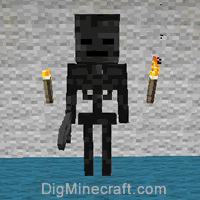NBT Tags for Skeleton in Minecraft (Java Edition 1.10)
This Minecraft tutorial explains the NBT tags (formerly called data tags) that you can use for a skeleton in Minecraft Java Edition (PC/Mac) 1.10.
TIP: If you are not running Minecraft Java Edition (PC/Mac) 1.10, find NBT tags for skeleton in another version of Minecraft:
Background
In Minecraft Java Edition 1.10, the entity value for a skeleton is Skeleton. The Skeleton entity has a unique set of data tags that can be used in Minecraft commands such as: /summon, /entitydata, /give, /fill, /setblock, /testfor.
Skeletonis used as the entity value for both skeleton and wither skeleton in Minecraft 1.10:


What are NBT tags (formerly called Data Tags)?
NBT tags allow you to set certain properties of an entity (such as Skeleton). The NBT tag is always surrounded in {} such as {SkeletonType:1}. If there is more than one NBT tag used in a game command, the NBT tags are separated by a comma such as {SkeletonType:1, CustomName:Bones}.
List of NBT Tags
Here is a list of the NBT tags that you can use for Skeleton in Minecraft Java Edition (PC/Mac) 1.10:
| NBT Tag | Value (Description) | Works With |
|---|---|---|
| SkeletonType | 0 (The skeleton is a normal skeleton) Example |
/summon /entitydata |
| CanPickUpLoot | 0 (The skeleton can not pick up loot off the ground) Example |
/summon /entitydata |
| CustomName | name (The name to assign to the skeleton. If the name has spaces, you need to surrounded the name value in "".) Example |
/summon /entitydata |
| Health | number (The number of health points the skeleton has) Example |
/summon /entitydata |
| AbsorptionAmount | number (The number of absorption health points the skeleton has) Example |
/summon /entitydata |
| Invulnerable | 0 (The skeleton will take damage like normal) Example |
/summon /entitydata |
| PersistenceRequired | 0 (The skeleton will despawn naturally) Example |
/summon /entitydata |
| NoAI | 0 (The skeleton will have artificial intelligence and will move/behave like normal) Example |
/summon /entitydata |
| Silent | 0 (The skeleton will make its usual noises in the game) Example |
/summon /entitydata |
| Fire | ticks (The number of game ticks until the skeleton is no longer on fire - there are 20 ticks in a second) Example |
/summon /entitydata |
| PortalCooldown | ticks (The number of game ticks until the skeleton can go through a portal again - there are 20 ticks in a second) Example |
/summon /entitydata |
| Air | ticks (The number of game ticks the skeleton has air left for) Example |
/summon /entitydata |
| HandItems | Items that the skeleton is holding in its hands, listed in this order: right hand, left hand Syntax Example |
/summon /entitydata |
| HandDropChances | The drop chances for each of the 2 items listed in HandItems. A value of 1.0f means 100% chance of the item being dropped when the skeleton is killed, 0.5f means 50%, 0.2f means 20%, and so on. Example |
/summon /entitydata |
| ArmorItems | Items of armor that the skeleton is wearing, listed in this order: boots, leggings, chestplate, helmet Syntax Example |
/summon /entitydata |
| ArmorDropChances | The drop chances for each of the 4 items listed in ArmorItems. A value of 1.0f means 100% chance of the item being dropped when the skeleton is killed, 0.5f means 50%, 0.2f means 20%, and so on. Example |
/summon /entitydata |
| UUIDLeast | A number that specifies the right half of the UUID for the skeleton (use UUIDLeast and UUIDMost to target/find a particular skeleton in the game) Example |
/summon /entitydata |
| UUIDMost | A number that specifies the left half of the UUID for the skeleton (use UUIDLeast and UUIDMost to target/find a particular skeleton in the game) Example |
/summon /entitydata |
| id | Skeleton (The entity value used to represent a skeleton in the EntityTag or Passengers tag) Example |
/summon /give |
| Passengers | The mob that is riding on the skeleton. Use the entity value for the passenger mob Example of zombie as passenger |
/summon /entitydata |
NBT Tag Examples
To summon a wither skeleton:
/summon Skeleton ~ ~ ~ {SkeletonType:1}
To summon a wither skeleton that is named Bones:
/summon Skeleton ~ ~ ~ {SkeletonType:1, CustomName:Bones}
To summon a skeleton that is named "The Killer" who is wearing a set of full diamond armor. Use a command block to run this command:
/summon Skeleton ~ ~1 ~ {CustomName:"The Killer", ArmorItems:[{id:diamond_boots}, {id:diamond_leggings}, {id:diamond_chestplate}, {id:diamond_helmet}], ArmorDropChances:[1.0f,1.0f,1.0f,1.0f]}
To give the closest player a skeleton spawn egg in Minecraft Java Edition (PC/Mac) 1.10:
/give @p spawn_egg 1 0 {EntityTag:{id:Skeleton}}
Target Selectors
Before we finish discussing data tags, let's quickly explore how to use the @e target selector. The @e target selector allows you to target entities in your commands. If you use the type=Skeleton value, you can target skeletons:
@e[type=Skeleton]
You can also add a radius value to target skeletons within a certain radius of blocks (for example, r=5 lets you target skeletons within a 5 block radius of where the command is run):
@e[type=Skeleton,r=5]
Target Selector Examples
To change all skeletons into wither skeletons within a 5 block radius:
/entitydata @e[type=Skeleton,r=5] {SkeletonType:1}
To test for all skeletons within a 9 block radius:
/testfor @e[type=Skeleton,r=9]
To summon a lightning bolt at all skeletons:
/execute @e[type=Skeleton] ~ ~ ~ /summon LightningBolt
To kill all skeletons:
/kill @e[type=Skeleton]
Next, learn how to use the game commands in Minecraft.
Command Examples
Here are some game command examples for a skeleton in Minecraft:
Command Generators
If you need help, you can use these tools to automatically generate commands for you:
Advertisements






